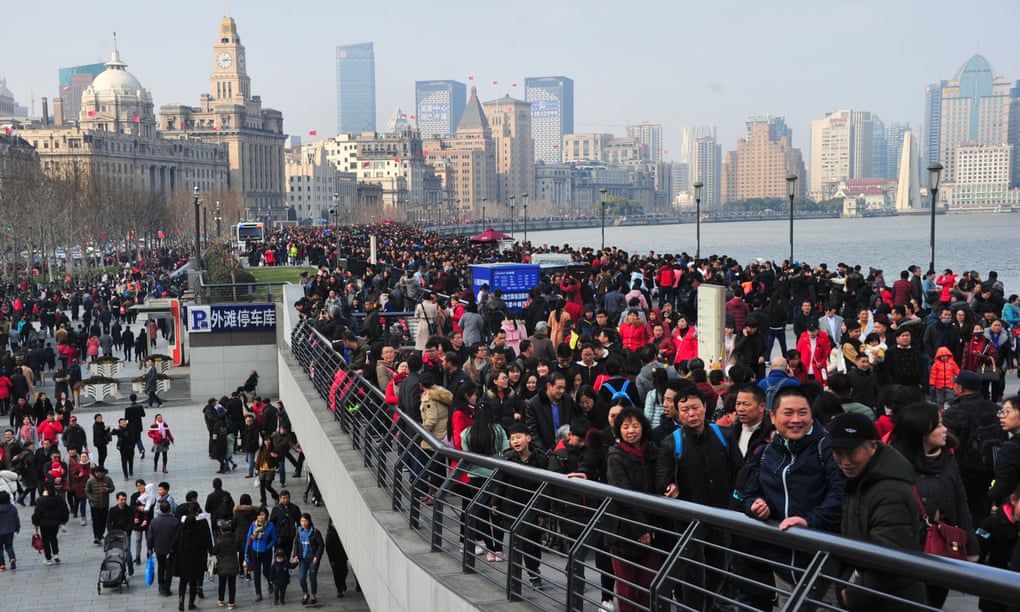By Javier C. Hernánez and Quoctrung Bui, The New York Times, November 18, 2018
 |
| Chinese middle-class numbers 300 million. Shanghai during the Chinese New Year holiday in February. Photograph: Imaginechina/REX/Shutterstock |
China is still much poorer overall than the United States. But the Chinese have taken a commanding lead in that most intangible but valuable of economic indicators: optimism.
In a country still haunted by the Cultural Revolution, where politics are tightly circumscribed by an authoritarian state, the Chinese are now among the most optimistic people in the world — much more so than Americans and Europeans, according to public opinion surveys.
What has changed?
Most of all, an economic expansion without precedent in modern history.
Eight hundred million people have risen out of poverty. That’s two and a half times the population of the United States.

1.2 billion people
1.0
Not in poverty
0.8
0.6
0.4
In poverty
0.2
2015
1990
1995
2000
2005
2010
Source: The World Bank. People in poverty live at or below $1.90 a day.
Not only are incomes drastically rising within families, but sons are outearning their fathers. That means expectations are rising, too, especially among China’s growing middle class.
Life expectancy has also soared. Chinese men born in 2013 are expected to live more than seven years longer than those born in 1990; women are expected to live nearly 10 years longer.
“It feels like there are no limits to how far you can go,” said Wu Haifeng, 37, a financial analyst who was born to a family of corn farmers in northern China and now earns more than $78,000 a year. “It feels like China will always be strong.”
There are risks, of course, and no guarantees that China’s rise will continue indefinitely.
A prolonged economic slump could inflict major damage. And experts warn that China could fall into the middle-income trap — in which growth and earnings plateau — if it fails to address high corporate debt levels or doesn’t do more to encourage innovation. Demography is also a ticking bomb: China is racing to get rich before it gets old.
Yet for now, the economic arc seems ever upward.
Like the United States, China still has a yawning gap between the rich and the poor — and the poorest Chinese are far poorer, with nearly 500 million people, or about 40 percent of the population, living on less than $5.50 a day, according to the World Bank.
But by some measures Chinese society has about the same level of inequality as the United States. Here are the world’s major countries ordered by inequality and income mobility.

Finland
More
mobile
Denmark
20%
Norway
Germany
Canada
How much a child’s
income is determined
by their parents’
Sweden
Netherlands
Japan
40%
Spain
China
Italy
United
Kingdom
United
States
60%
Brazil
South Africa
India
80%
Egypt
More equal
60
50
40
30
100%
Level of inequality
(Gini coefficient)
Source: The World Bank, Fair Progress, Economic Mobility Across Generations Around the World; World Development Indicators
Today, the economic output per capita in China is $12,000, compared with $3,500 a decade ago. The number is far higher in the United States, $53,000.
Yet few analysts doubt where the bigger increases will come. Here’s how modern China’s per-capita G.D.P. growth compares so far:

United States
$50k per capita G.D.P.
$40k
Japan
South Korea
$30k
$20k
China
$10k
0
20
40
60
80
100
120
140
160
Number of years since each country reached China’s per-capita G.D.P. in 1993
In 2011 U.S. dollars. |Source: Maddison Project.
China’s progress is especially remarkable given how the government has used social engineering to restrict where people live and how many children they have. Loosening those constraints could accelerate income growth.
This is why many people now talk about “the Chinese Dream.”
Xu Liya, 49, once tilled wheat fields in Zhejiang, a rural province along China’s east coast. Her family ate meat only once a week, and each night she crammed into a bedroom with seven relatives.
Then she attended university on a scholarship and started a clothing store. Now she owns two cars and an apartment valued at more than $300,000. Her daughter attends college in Beijing.
“Poverty and corruption have hurt average people in China for too long,” she said. “While today’s society isn’t perfect, poor people have the resources to compete with rich people, too.”
No comments:
Post a Comment